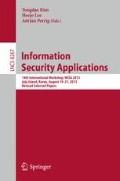Abstract
In recent years, researchers have relied heavily on labels provided by antivirus companies in establishing ground truth for applications and algorithms of malware detection, classification, and clustering. Furthermore, companies use those labels for guiding their mitigation and disinfection efforts. However, ironically, there is no prior systematic work that validates the performance of antivirus vendors, the reliability of those labels (or even detections), or how they affect the said applications. Equipped with malware samples of several malware families that are manually inspected and labeled, we pose the following questions: How do different antivirus scans perform relatively? How correct are the labels given by those scans? How consistent are AV scans among each other? Our answers to these questions reveal alarming results about the correctness, completeness, coverage, and consistency of the labels utilized by much existing research. We invite the research community to challenge the assumption of relying on antivirus scans and labels as a ground truth for evaluating malware analysis and classification techniques.
Access this chapter
Tax calculation will be finalised at checkout
Purchases are for personal use only
Notes
- 1.
- 2.
We use malware samples accumulated over a period of a year (mid 2011 to 2012). As we will see later, this would give the AV vendors an advantage and might overestimate their performance compared to more emerging threats (APT).
- 3.
The greedy strategy, by adding the AV scan with least overlap to the current set, is the best known approximation [21].
References
VirusTotal - Free Online Virus, Malware and URL Scanner. https://www.virustotal.com/en/ August 2013
Bailey, M., Oberheide, J., Andersen, J., Mao, Z.M., Jahanian, F., Nazario, J.: Automated classification and analysis of internet malware. In: Kruegel, C., Lippmann, R., Clark, A. (eds.) RAID 2007. LNCS, vol. 4637, pp. 178–197. Springer, Heidelberg (2007)
Bayer, U., Comparetti, P.M., Hlauschek, C., Krügel, C., Kirda, E.: Scalable, behavior-based malware clustering. In: NDSS (2009)
Kerr, D.: Ubisoft hacked; users’ e-mails and passwords exposed. http://cnet.co/14ONGDi July 2013
Kinable, J., Kostakis, O.: Malware classification based on call graph clustering. J. Comput. Virol. 7(4), 233–245 (2011)
Kong, D., Yan, G.: Discriminant malware distance learning on structural information for automated malware classification. In: Proceedings of the 19th ACM SIGKDD Conference on Knowledge Discovery and Data Mining (2013)
Kruss, P.: Complete zeus source code has been leaked to the masses. http://www.csis.dk/en/csis/blog/3229 March 2011
Lanzi, A., Sharif, M.I., Lee, W.: K-tracer: a system for extracting kernel malware behavior. In: NDSS (2009)
Mohaisen, A., Alrawi, O.: Unveiling zeus: automated classification of malware samples. In: WWW (Companion Volume), pp. 829–832 (2013)
Mozzherina, E.: An approach to improving the classification of the New York Times annotated corpus. In: Klinov, P., Mouromtsev, D. (eds.) KESW 2013. CCIS, vol. 394, pp. 83–91. Springer, Heidelberg (2013)
Park, Y., Reeves, D., Mulukutla, V., Sundaravel, B.: Fast malware classification by automated behavioral graph matching. In: CSIIR Workshop, ACM (2010)
Perdisci, R., Lee, W., Feamster, N.: Behavioral clustering of http-based malware and signature generation using malicious network traces. In: USENIX NSDI (2010)
Rieck, K., Holz, T., Willems, C., Düssel, P., Laskov, P.: Learning and classification of malware behavior. In: Zamboni, D. (ed.) DIMVA 2008. LNCS, vol. 5137, pp. 108–125. Springer, Heidelberg (2008)
Rieck, K., Trinius, P., Willems, C., Holz, T.: Automatic analysis of malware behavior using machine learning. J. Comput. Secur. 19(4), 639–668 (2011)
Rossow, C., Dietrich, C.J., Grier, C., Kreibich, C., Paxson, V., Pohlmann, N., Bos, H., van Steen, M.: Prudent practices for designing malware experiments: status quo and outlook. In: IEEE Symposium on Security and Privacy (2012)
Sharif, M.I., Lanzi, A., Giffin, J.T., Lee, W.: Automatic reverse engineering of malware emulators. In: IEEE Symposium on Security and Privacy (2009)
Shaw, A.: Livingsocial hacked: cyber attack affects more than 50 million customers. http://abcn.ws/15ipKsw April 2013
Silveira, V.: An update on linkedin member passwords compromised. http://linkd.in/Ni5aTg July 2012
Strayer, W.T., Lapsley, D.E., Walsh, R., Livadas, C.: Botnet detection based on network behavior. In: Lee, W., Wang, C., Dagon, D. (eds.) Botnet Detection. Advances in Information Security, vol. 36. Springer, New York (2008)
Tian, R., Batten, L., Versteeg, S.: Function length as a tool for malware classification. In: IEEE MALWARE (2008)
Vazirani, V.V.: Approximation Algorithms. Springer, Heidelberg (2004)
Yan, G., Brown, N., Kong, D.: Exploring discriminatory features for automated malware classification. In: Rieck, K., Stewin, P., Seifert, J.-P. (eds.) DIMVA 2013. LNCS, vol. 7967, pp. 41–61. Springer, Heidelberg (2013)
Zhao, H., Xu, M., Zheng, N., Yao, J., Ho, Q.: Malicious executables classification based on behavioral factor analysis. In: IC4E (2010)
Acknowledgement
We would like to thank Andrew West for proofreading this work, and Allison Mankin and Burt Kaliski for their feedback. We would like to further thank Trevor Tonn, Ryan Olson, Brandon Dixon, Leo Fernandes, and Blake Hartstein for sharing with us the dataset and for their valuable feedback.
Author information
Authors and Affiliations
Corresponding author
Editor information
Editors and Affiliations
Rights and permissions
Copyright information
© 2014 Springer International Publishing Switzerland
About this paper
Cite this paper
Mohaisen, A., Alrawi, O., Larson, M., McPherson, D. (2014). Towards a Methodical Evaluation of Antivirus Scans and Labels. In: Kim, Y., Lee, H., Perrig, A. (eds) Information Security Applications. WISA 2013. Lecture Notes in Computer Science(), vol 8267. Springer, Cham. https://doi.org/10.1007/978-3-319-05149-9_15
Download citation
DOI: https://doi.org/10.1007/978-3-319-05149-9_15
Published:
Publisher Name: Springer, Cham
Print ISBN: 978-3-319-05148-2
Online ISBN: 978-3-319-05149-9
eBook Packages: Computer ScienceComputer Science (R0)

